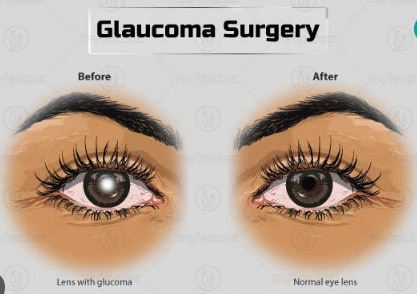Glaucoma refers to increased intraocular pressure (IOP) in the eye, which can damage the optic nerve and cause vision loss. Glaucoma surgery is a medical procedure used to treat glaucoma. Glaucoma surgery reduces the pressure inside the eye by improving the drainage of the fluid (aqueous humor) or by reducing its production, thereby preventing further damage to the optic nerve.
Need for Glaucoma Surgery
Glaucoma develops gradually and is usually managed with medications such as eye drops or oral medication that can lower the IOP. But in some cases, when medications and laser treatments are not sufficient or when the disease has progressed, surgery becomes necessary. Surgery helps to prevent permanent vision loss, especially in more advanced or refractory cases.
The goal of Glaucoma Surgery
The main goal of glaucoma surgery is to lower intraocular pressure (IOP) and to prevent damage to the optic nerve. This is done by
- Improving drainage of the fluid called aqueous humor inside the eye can relieve pressure.
- By reducing the production of aqueous humor, the fluid volume in the eye is reduced.

ALL YOU NEED TO KNOW BEFORE GOING FOR GLAUCOMA SURGERY
Types of Glaucoma
| Type of Glaucoma | Description | Symptoms | Risk Factors | Treatment Options |
| Open-Angle Glaucoma | It is the most common type of glaucoma, characterized by a gradual blockage of the drainage angle in the eye. | No early signs & symptoms, peripheral vision loss | Age, family history, ethnicity (African descent) | Medications (eye drops), laser therapy, surgery |
| Angle-Closure Glaucoma | Caused by the sudden blocking of the drainage angle, which increases the IOL pressure rapidly | Severe eye pain, nausea, blurred vision | Far-sightedness, age, ethnicity (Asian descent) | Emergency treatment, medications, laser surgery |
| Normal-Tension Glaucoma | Caused by optic nerve damage even after normal IOL pressure levels | No early symptoms, peripheral vision loss, and pressure is normal | Low blood pressure, Genetics predisposition | Medications (Oral & eye drops), surgery, monitoring |
| Congenital Glaucoma | Develops during birth due to abnormal development of the eye’s drainage system. | Enlarged eyes, sensitivity to light, blurred vision | Family history of glaucoma, genetic conditions | Eye surgery to correct drainage issues |
| Secondary Glaucoma | Develops due to another eye injury or trauma, such as inflammation. | Depends upon the secondary cause | Long use of medications(steroids), injury, eye inflamation | Treating the underlying cause, medications, surgery |
Types of Glaucoma Surgery
Glaucoma surgery is performed when medications and other treatments are not sufficient to control intraocular pressure (IOP). High IOP can damage the optic nerve and lead to vision loss. So that requires going through glaucoma surgery.
The main types of glaucoma surgery are specifically designed to reduce the IOP by improving the drainage of fluid called as aqueous humor from the eye. Below are the main types of glaucoma surgery:
Trabeculectomy
This is the most common glaucoma surgery that involves creating a small hole in the white part of the eye, called the sclera, to allow fluid to drain out of the eye. After performing this operation, a small, controlled pocket is formed under the thin membrane called the conjunctiva that also covers the eye. The pocket formation acts as a reservoir for the aqueous humor, which ultimately lowers IOP.
Trabeculectomy is generally recommended for patients with open-angle glaucoma and especially for advanced glaucoma that hasn’t responded well to medication or other treatment, such as laser therapy.
Glaucoma Drainage Implants (Tube Shunt Surgery) and its types
This Glaucoma surgery involves implanting a small tube into the eye that helps drainage of aqueous humor liquid into a reservoir or bleb. This tube is placed into the eye and connected to a small plate under the thin membrane called the conjunctiva.
This surgery is typically used in more advanced cases of glaucoma where medications and other treatments are not effective, especially when trabeculectomy is not an option or has failed.
There are different types of drainage implants used in glaucoma surgery
a) Ahmed Glaucoma Valve
In this type, the implant has a small valve that is used to regulate the flow of aqueous humor. Valve helps to prevent excessive drainage of aqueous humor and hence reducing the risk of hypotony (low IOP) and complications.
b) Baerveldt Glaucoma Implant
In this type, the implant consists of a flexible silicone tube that is connected to a larger plate. It provides more drainage surface area so this type is mostly beneficial in patients with more severe glaucoma.
c) Molteno Implant
This type of implant is often used in more complex cases of glaucoma. This is almost similar to the Baerveldt implant, where the Molteno implant consists of a tube connected to a plate.
Laser Surgery (Laser Trabeculoplasty and Laser Iridotomy)

This type of glaucoma surgery is generally used to reduce IOP in the eye. Laser glaucoma surgery is a less invasive option. There are mainly two types of Laser Glaucoma Surgery:
Laser Trabeculoplasty
In this type of surgery, a laser is used to treat the drainage system called trabecular meshwork inside the eye. It is commonly used for open-angle glaucoma to help improve fluid drainage.
Laser Iridotomy:
In this type of procedure, the surgeon typically involves making a small hole in the peripheral iris to allow the aqueous humor to flow more freely between the anterior chamber and the posterior chamber of the eye. This type of surgery is used for angle-closure glaucoma.
Minimally Invasive Glaucoma Surgery (MIGS)
As the name suggests, it is a less invasive surgical technique that is specifically designed to lower IOP with fewer complications. Compared to other traditional surgeries, MIGS provides a faster recovery time. MIGS includes the following procedure:
iStent
In this, a small stent is placed in the eye to help fluid drain more easily
Hydrus Microstent:
A microstent is inserted into the drainage system called trabecular meshwork to drain the fluid.
Trabectome
A small surgical tool is used to remove part of the trabecular meshwork, which helps fluid to drain more easily.
MIGS procedures are recommended for patients with moderate symptoms of open-angle glaucoma and those who are not responding well to medications and also want to avoid the risks of traditional surgery.
Cyclophotocoagulation
This type of procedure involves using a laser to target the ciliary body to reduce fluid production. The ciliary body is the part of the eye that produces aqueous humor. The main purpose of this type of surgery is to decrease IOP by lowering the amount of fluid produced in the eye.
This type of glaucoma surgery is performed for advanced or refractory glaucoma when other surgical options are not suitable or have failed. It is often used for patients with glaucoma who have very high IOP that is difficult to control.
Deep Sclerectomy
This procedure involves creating a small filtration channel in the eye’s sclera, which is the outer layer of the eye, while leaving the trabecular meshwork intact. The filtering bleb is created under the thin membrane of the eye called conjunctiva to allow for the drainage of aqueous humor and, hence, lowering IOP.
This type of surgery is generally performed for cases of open-angle glaucoma and is considered when other treatments and medications do not affect the eye’s health.
Scleral Buckling
This type of procedure is rarely used for glaucoma surgery but is more commonly used for retinal detachment and can sometimes be used in complex glaucoma cases to stabilize the eye and reduce IOP pressure.
| Type of Surgery | Description | Procedure | Risks & Benefits |
| Trabeculectomy | It’s a traditional surgery performed to create a new drainage pathway for fluid in the eye. | A very small hole is created in the sclera (white part of the eye) to allow fluid to drain and reduce pressure. | It is effective for many patients, but contains the risk of infection, scarring, bleeding, and vision changes |
| Tube Shunt Surgery | A small shunt (tube) is placed to drain fluid from the eye. | A silicone tube is implanted in the eye to help drain fluid and lower intraocular pressure. | This surgery is beneficial for advanced glaucoma cases however it contains few risks such as infection, tube dislocation, low eye pressure |
| Laser Surgery | Use laser-focused light to treat the eye and reduce the pressure | Types include: | |
| – Laser Trabeculoplasty | Increases the fluid outflow by targeting the eye drainage system | Laser is applied to the trabecular meshwork to improve fluid drainage. | Quick recovery and outpatient procedure, inflammation, temporary discomfort |
| – Laser Iridotomy | This process involves treating narrow-angle glaucoma by creating a hole in the iris to improve fluid flow. | A laser creates a small hole in the iris to allow better fluid movement. | Procedure is very quick, and it reduced the risk of angel-closure glaucoma, risk of increasing eye pressure |
| Minimally Invasive Glaucoma Surgery (MIGS) | It’s a newer group of surgeries performed to lower eye pressure | Stents or Tiny devices are inserted into the eye to improve the fluid drainage | Less risk, faster recovery, less pain but it has limited effectiveness for advanced glaucoma |
| – iStent | A small devices is implanted in eye which help in draining fluid | A stent is inserted in the eye’s drainage angle. | Requires very less time, and reduced need of medication. It has the risks of device malfunction and inadequate pressure control few times. |
| – Hydrus Microstent | Another type of device/stent is inserted which help in improving drainage and reducing pressure | The microstent is implanted in the eye’s drainage system. | Benefits: Quick recovery, suitable for early glaucoma. Risks: Infection, migration of the stent. |
Conclusion
As per the above discussion, we can conclude that each type of glaucoma surgery is performed based on the specific needs of the patient, depending on the type of glaucoma, along with its severity and, the patient’s response to other treatments and medications. Glaucoma surgery can play a key role in preventing further damage to the optic nerve if glaucoma is not effectively managed with medication. The main purpose of surgery is to lower intraocular pressure and preserve vision while minimizing risks and recovery time.
What is the most successful glaucoma surgery?
The best surgical option depends on factors such as the type and severity of glaucoma, the patient’s age, health, other medical conditions, and whether the patient has had prior surgeries. For example, trabeculectomy is best in many cases of open-angle glaucoma, and tube shunt surgery is mostly preferred in more complex cases. Minimally Invasive Glaucoma Surgery(MIGS) is very popular due to its safety and minimal invasiveness, especially in early or moderate glaucoma.
When is glaucoma surgery necessary?
Glaucoma surgery is considered when other treatments, such as medications such as eye drops or laser therapy, don’t control intraocular pressure (IOP) and when the glaucoma is more advanced and requires more aggressive intervention. Other factors such as the progression of Glaucoma despite treatment, Complicated or Refractory Glaucoma, or vision loss becoming significant are the cases when glaucoma surgery becomes necessary. The final decision to proceed with surgery is individualized and depends on a detailed evaluation by an ophthalmologist. Factors like health status, type of glaucoma, age, severity of disease, and previous treatments can influence the decision.
What is the success rate of glaucoma surgery?
The success rate of glaucoma surgery depends on several factors such as the severity, type of glaucoma surgery, patient’s overall health, postoperative care and Follow-Up, and how well they respond to surgery. The success rate of trabeculectomy and laser trabeculoplasty is around 70-80% for lowering and maintaining effective intraocular pressure (IOP) for at least 5 years. The success rate for Minimally Invasive Glaucoma Surgery (MIGS) is about 60-80% in reducing IOP. Successful surgery means maintaining and lowering IOP, preventing further damage to the optic nerve and preserving vision. At the same time, complications can arise, including infection, scarring, or a need for further treatment. Patients should discuss their options thoroughly with their ophthalmologist to understand the potential benefits and risks.
What are the side effects of Glaucoma surgery?
Glaucoma surgery is necessary to control intraocular pressure (IOP) and prevent further vision loss. While glaucoma surgery has a High Success Rate, there are some risks and potential side effects depending on the type of surgery, the patient’s overall health, and how the individual responds to the procedure. Some potential side effects of glaucoma surgery are Infection, bleeding, Hypotony (Low Intraocular Pressure), Double Vision (Diplopia), Cataract Formation, Choroidal Effusion or Choroidal Hemorrhage, Vision Changes or Fluctuations. It’s essential to discuss the potential risks and benefits of glaucoma surgery with your ophthalmologist before making any decisions.
What can I do to help my eye heal after surgery?
After glaucoma surgery, proper care and following your ophthalmologist’s instructions are essential for healing and achieving the best possible outcome. Following postoperative Instructions, such as medications, dosage & timing, and avoiding touching the Eye are some key factors for accurate results. Limiting your physical activities for example, avoiding strenuous exercise and swimming. Avoid smoking and alcohol, as it can slow down the healing process and increase the risk of complications. Drinking plenty of water helps maintain overall health, and eating a healthy, balanced diet can support the healing process. Foods rich in vitamin C, vitamin A, and zinc may promote eye health and healing.
Reviewed By
Dr. Sonam Aggarwal
lMBBS, MD(C.Medicine)
